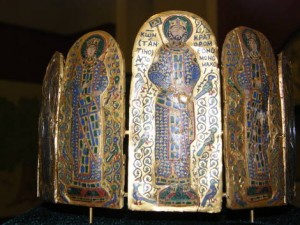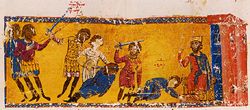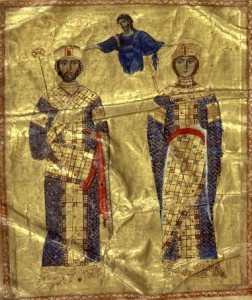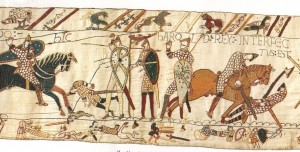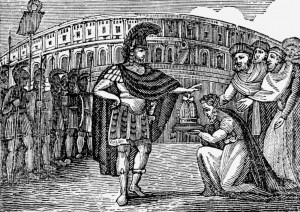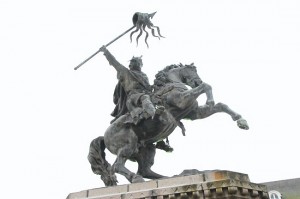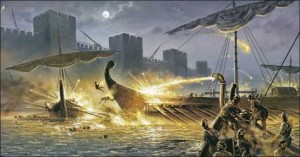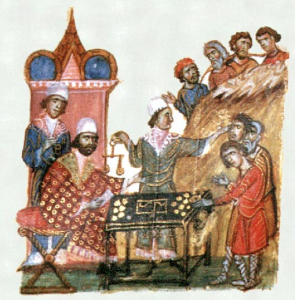 Listener Stuart asks what Byzantium’s policy was concerning the Jews.
Listener Stuart asks what Byzantium’s policy was concerning the Jews.
There are two things that make this a difficult question to answer. The first is that the exact imperial policy tended to change depending on who the emperor was, and the second is that from the vantage point of the twenty-first century medieval attitudes toward Judaism- even the most “enlightened”- can look pretty barbaric. Generally speaking, however, we can say that Jews were more accepted in the Byzantine Empire than in the West. There were the occasional hostilities, but no systematic persecutions or mass expulsions like those common in Western Europe at the time.
Theodosius I officially recognized Judaism as a lawful religion, but forbade intermarriage with Christians and barred Jews from the civil service and the military. Theodosius II extended the ban to all public offices both civilian and military- with the notable exception of the office of decurion (tax collectors). Jews who circumcised non-Jews were exiled, and conversion to Judaism was technically illegal (although apostate Jews were allowed to leave Christianity for their former faith). They were also allowed to own Christian slaves- and pass them to their children- but not to purchase new ones. Justinian (trying to eradicate all religious divisions- including heretics, pagans, and Jews) banned the construction of any new synagogues and ordered all existing ones to be converted to churches. These draconian measures, however, had little real effect. There is only one recorded instance of this (sort of) happening – in North Africa a synagogue on the Berber frontier was converted to a barracks for military reasons- and archaeological evidence suggests that these official decrees had little sway over synagogue building in Palestine.
This gap between instructions coming out of Constantinople and follow-through in the territories was probably true through most of imperial history. The fact that Justinian felt the need to specifically forbid Jews from holding public office- a law which had already been on the books for over two centuries- suggests that the imperial edicts were either unenforced or unenforceable.
This kind of de jure restriction and de facto toleration didn’t inspire much loyalty from Byzantine Jews. In 556 there were riots in Caesarea serious enough to kill the governor, in 608 the Patriarch of Antioch was seized and dragged through the streets by the local Jewish population, and in 614 the Jews of Jerusalem sided with the invading Persians and participated in the wholesale slaughter of their Christian neighbors. When a Jewish leader was asked why he had participated he responded with the answer: ‘because these Christians are the enemies of my faith’. Clearly the ill-will cut both ways.
Despite these occasional outbursts on both sides, the centuries after Justinian were characterized by marked toleration- probably because the empire was fighting for its life. In the six hundred years between the reigns of Justin II (565) and Alexius IV Angelus (1204) there were only four exceptions. Heraclius ordered the forced baptism of all Jews in the empire, as did Leo III, Basil I, and John Tzimiskes. Together they made up about 50 years of official “persecution” although by all accounts there was virtually no attempt to actually enforce it other than a few symbolic acts.
In fact, Jewish ancestry doesn’t seem to have been particularly troublesome for a man on the rise. One 9th century Byzantine Emperor (Michael II) had Jewish grandparents and grew up in a mixed household that retained many Jewish customs. Though called the “Amorian” (ie from the city of Amorium) he was the probable ancestor of the Leo the Wise and was therefore the true founder of the Macedonian Dynasty- the most brilliant family that the empire ever produced.
By 1176, the rabbi and traveler Benjamin of Tudela reported that there were about 2,500 Jews living in Constantinople, most involved in manufacturing silk or other mercantile activities. They were restricted to the Pera quarter of the city, but were generally treated with respect. Quite a few of them were wealthy and one even served as the current emperor’s personal physician.
The fourth Crusade was a catastrophe for Jews and Orthodox alike, but the Byzantine reconquest of the city in 1261 was a particular boon to the Jewish community. The emperors Michael VIII and his son Andronicus II were even condemned by the Patriarch of Alexandria for their “excessive toleration of the Jews”- probably because they didn’t enforce ghettoization and allowed Jews to live among Christians. By the 14th century the empire was in an advanced state of decay and forced to give foreigners- particularly Venetians- special privileges. Many of the remaining Jews in Constantinople purchased Venetian citizenship and benefited from a more favorable tax structure and greater trading rights. Ironically enough for an empire that had at one time attempted to convert its Jewish population, by 1453 the Jews in Constantinople probably had a broader set of rights than their Christian neighbors.
Of course that was only by virtue of their Venetian citizenship, but as any of their ancestors could have pointed out, much better to have rights for the wrong reasons than to have no rights at all.
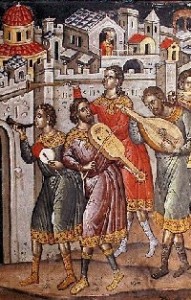 Reader Spencer asks what Byzantine music sounded like and if there is any way to hear it today.
Reader Spencer asks what Byzantine music sounded like and if there is any way to hear it today.
